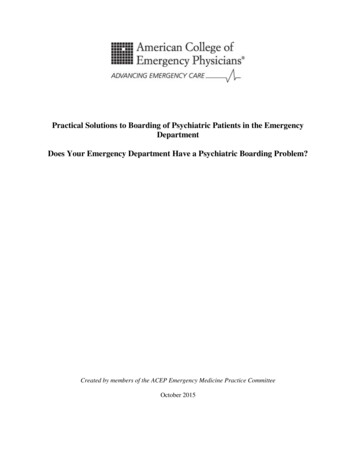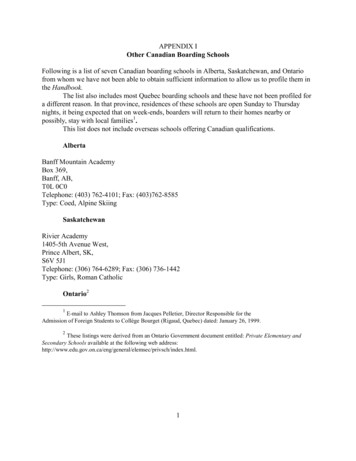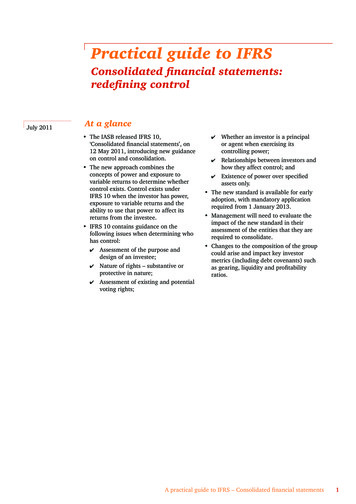
Transcription
Practical Solutions to Boarding of Psychiatric Patients in the EmergencyDepartmentDoes Your Emergency Department Have a Psychiatric Boarding Problem?Created by members of the ACEP Emergency Medicine Practice CommitteeOctober 2015
Practical Solutions to Boarding of Psychiatric Patients in the Emergency DepartmentDoes Your Emergency Department Have a Psychiatric Boarding Problem?An Information PaperOf the estimated 136 million emergency visits yearly, 5%, or nearly 7 million Americans, present to ouremergency centers with a primary psychiatric emergency. Limited funding, limited resources, and patientplacement difficulties have cumulated to the current crisis of mental health patients boarding in the emergencydepartment (ED).Hospital crowding and the boarding of medical patients in the ED continues to occur despite overwhelmingliterature that associates this practice with serious patient safety issues and higher mortality rates. The issuesaround mental health patient boarding differ in many ways from those of medical patient boarding. Theunderlying issue is still the inability of admitted patients to go to an inpatient bed. However, many mental healthfacilities do not operate under EMTALA rules and may “cherry-pick” the patients they receive. Hospitals mayrefuse to accept a patient because of comorbidities or means of payment. Most importantly, patients with mentalhealth issues often fail to receive a detailed evaluation, any re-evaluation, and any mental health-related carewhile they are waiting.According to a 2015 Emergency Medicine Practice Research Network (EMPRN) poll 70% of the emergencyphysicians surveyed reported psychiatry patients being boarded on their last shift! Over half reported averageboarding times of up to two days and up to five patients at a time. The backup and boarding EDs of psychiatricpatients waiting for an evaluation or inpatient bed is a troubling phenomenon on a national scale for EDs andmental health consumers alike. The crisis condition of the ED provides a clear picture of a mental health caresystem in complete dysfunction.Clinical experience has shown that a call primarily for the creation of more inpatient beds is, at best, a onedimensional solution to a complex problem. It may also be regressive. The emergency department is a “room witha view.”9 Individuals who are being boarded, if examined in their particularity, prove to be reflections andindicators of the many different aspects of the local mental health system that require improvement. Insufficientinpatient beds may or may not be one of them.The plight and sheer numbers of these patients can become a powerful motivator for bringing together a broadbased action group of stakeholders in the community besides EDs: the private, public, and academic sectors ofmental health care; law enforcement; court system; patient advocates; peer specialists; relevant social agencies;and politicians and policy-makers. Ultimately simple boarding statistics can serve as an elegant metric of thesuccess or failure of the various, concerted efforts that a reform-minded community might undertake.In this document, we have input from various leaders in emergency medicine and take a peek into how individualstried to solve this problem at the local, regional, and state level. Although no one mechanism is likely to fix thenational problem, one or a combination of these methods may help your individual practice and ultimatelyprovide better care to the population. The most common solutions are listed below, with a brief description,followed by links and additional resources. These solutions are to serve as a guide that you may then combine andmorph into a solution that works best in your state, community, and ED.ooTelepsychiatry Services – This solution is important in increasing access to a psychiatrist in a more timelyfashion. There are various private companies offering this service across the country.Psychiatric Observation Units and Treatment Protocols – Specific psychiatric emergency departmentand/or observation units are utilized to pull psychiatric patients out of the general ED once they are stabilized
ooooooor medically cleared. Protocols to care for the patient during their lengthened observation stays are oftenhelpful.Patient Navigation/EMS Involvement – This can be approached from several aspects. One increasinglycommon approach is “Community Paramedicine Programs” in which paramedics help patients navigate theoften cumbersome health care environment. Additionally, some EMS agencies are clearing patients medicallyin the field and transporting them directly to psychiatric hospitals. Lastly, social workers and case managerscan serve as important navigators for patients.Mobile Crisis Units – These are usually teams of multidisciplinary mental health professionals that respondto individuals in the community requiring assistance with a psychiatric crisis. The team may include socialworkers, nurses, psychiatrists, psychologists, addiction specialists, mental health technicians, and peercounselors. The mobile crisis team can provide a range of services that can include assessment, crisisintervention, information, referrals, and supportive counseling.Regional/State Health Registries – A streamlined state or regional dashboard showing bed availabilitycoupled with available transfer mechanisms are helpful in reducing the time and effort it takes to get patientsto definitive care.Emergency Department Evaluation, Treatment, Re-evaluationProtocols for Safe Discharge – Evidence-based decision tools can be helpful in allowing an emergencyphysician to safely discharge a patient with a mental health disorder.Lessons Learned Case StudiesAs demonstrated, there is not one fix for this looming issue. It takes community, regional, state, and nationalstakeholders to tailor and implement methods that work best to serve the patients in your community.Telepsychiatry ServicesTelemedicine has been used in medicine for several years (eg, teleradiology, transmission of ECGs).Telemedicine is used to connect physicians with incarcerated patients, those in nursing homes, and those whowant after-hours consultations on the web. Telepsychiatry has been a service offered by many private companiesas well as developed within health care systems. Given the shortage of psychiatrists in our country, this deliverymethod of definitive psychiatric care has been shown to be very helpful. Some states such as Georgia haveembraced this technology and several vendors within the state provide services to urban and rural hospitals.1Telepsychiatry is generally provided via video conferencing. In the past, this required elaborate communicationmonitors for both the physician and the ED. Video conferencing through the web is simple and portable but mustbe compliant with Health Insurance Portability and Accountability Act (HIPAA) regulations.Patients with mental health issues often wait for care. At triage, they may be perceived as not having severeillness and wait for an initial assessment. However, that wait is often dwarfed by the wait to see a mental healthexpert. In a recent National Alliance on Mental Illness survey, 70% of patients reported waiting 10 hours or moreto see a mental health expert in the ED. Telemedicine offers the ability not only to decrease that wait, but toconnect the patient to a higher level of provider. In a recent survey of 1,333 emergency physicians, only 7% statedthat their patients are seen by a psychiatrist in the ED. Another 5% were using telepsychiatry.2 Telepsychiatry isone answer to the shortage of psychiatrists, especially those with expertise in child and adolescent psychiatry. Inrural areas, access to psychiatrists is very limited, with many counties throughout the country having nopsychiatrists at all. Waits for evaluation may exceed six months. Insurance coverage varies. While the Center forMedicaid and Medicare Services covers some services, state policies on telemedicine vary. The state of Texasrecently voted to not allow telemedicine.Emergency Psychiatry Services Three Basic Models of Emergency Psychiatry DeliveryZeller S. Treatment of Psychiatric Patients in Emergency Settings. Prim Psychiatry. 2010;17(6):35-41.
o Psychiatric consultant evaluating patients in medical ED. This is the most common model. Howevermost EDs do not have access to a psychiatrist and rely on psychiatric social workers/nurses andpsychologists to do the evaluation. This evaluation and decision to admit are often made days before thepatient is transferred to a bed. During that time the severity of illness often changes. Advantages: Lowest cost Easiest to implement Less stigma when mixed with all patients Disadvantages: Delay in arrival of psychiatric consultant Limited treatment options: typically admit versus discharge Not conducive setting to extended psychiatric treatments/observation Physical setting (noise, patient volume) not optimal for psychiatric healing Possibly unsafe environment for suicidal patients (instruments, etc) Staff may be less comfortable with psychiatric patientso Separate section of medical ED dedicated to mental health patients. While this model provides somesafety advantages, the model still relies on an evaluation by a mental health provider and has the sameissues outlined in the model above. Advantages: More nurturing, conducive environment to psychiatric care Still within medical ED, allowing for full medical assessment and treatment Often allows for more time to arrange an appropriate disposition Disadvantages: Segregation of patients may create stigma regarding treatment in separate wing Area may become overflow area for nonpsychiatric patients May end up with minimal treatment occurring during wait in this area for placemento Stand-alone Psychiatric Emergency Services (PES) Advantages: Staffed around the clock with psychiatric nurses and other mental health professionals More prompt diagnosis, treatment Typically have extended observation capability Can significantly reduce admission rate Allows for quick decompression of EDs Disadvantages Lacks immediate proximity to emergency medical services More expensive than other models Requires 24/7 staffing and physical locationo Psychiatric Emergencies – Goals of Care Treatment goals: Rule out medical etiologies of symptoms see “Medical Clearance of Psychiatric Patients in the ED”3 Stabilization of acute crises by means of engaging the patient, treating from the start, and focusingcare on the primary goal of safe disposition including discharge for outpatient care whenappropriate. Disposition and aftercare planPrinciples of Practice and CareEmergency Care Psychiatric Clinical Framework. Consensus Statement by AAEM, ANA, APNA, ENA,ISPMHN. March 2010.
oProtocols must implement evidence-based clinical guidelines for treatment of patients with mentalillness and substance abuse disorders Focused medical assessment Emergency psychiatric evaluationPsychiatric Evaluation and Stabilization UnitsInpatient mental health beds have decreased over the past several decades, and limited reimbursement particularlyfor Medicaid recipients provides incentives to delay transfer of these patients. Once it has been determined that apatient needs inpatient treatment, another waiting period sometimes begins.As EDs and health facilities across the country see the volume of psychiatric emergencies rise, many health caresystems are establishing new ways to effectively and efficiently deliver care to a significant segment of thispatient population. This has commonly resulted in the development of psychiatric observation units andpsychiatric-specific EDs. These units do not replace the need for inpatient beds for new-onset mental illness or themost severely ill psychiatric patients, but can be a useful approach for many acute patients. As with any newdelivery model, however, procedures and protocols can be challenging to establish. As such, the informationbelow is intended to be a general resource for this task. It is largely based on a recommendation paper from theAPA Task Force on Psychiatric Emergency Services.Evaluation and Stabilization Units StandardsReport and Recommendations Regarding Psychiatric Emergency and Crisis Services. APA Task Force onPsychiatric Emergency Services. 2002.This report provides an overview on the provision of services for patients requiring emergency psychiatricservices. Hospital-based services, including psychiatric consultation with an emergency physician, specializedpsychiatric ED, extended observation or crisis hospitalization, and a variety of community services are presentedwith a focus on crisis care for individuals with mental health emergencies.Patient NavigationSome patients presenting to the ED with behavioral health crises may not require emergent inpatient treatment,but they may not be safe for unsupervised discharge. Patient navigation helps these patients connect withcommunity resources to prevent the need for inpatient beds and ED recidivism. A social worker or case managercan be a strong navigator. Community health workers or other staff can also be trained to fill this role.Navigators can communicate in real time with a patient’s family or social support network and outpatient healthproviders to plan a safe discharge. Navigators should be familiar with all available mental health and substanceabuse resources in the community. Navigators can then provide referrals to or schedule patients for promptoutpatient mental health appointments, community support groups, or other existing community resources prior todischarge from the ED. They can help patients connect with other social services such as housing that also helpstabilize their mental health crisis. Navigators may contact the patient after discharge to ensure that patientsremain safe and are successfully following their discharge plans.Community resources that a navigator may use for a patient’s discharge plan include:4 Early intervention programs Mobile crisis units Crisis hotlines Crisis stabilization centers
Peer support servicesHome mental health careTelepsychiatryCase managementOutpatient careAdult day carePartial hospitalizationResidential treatment programsThe American Hospital Association (AHA) encourages hospitals to take a proactive approach to behavioral healthprevention. The AHA emphasizes that investment in community resources or even expansion of a hospital’s ownbehavioral health services can be financially feasible by offsetting emergency care including patient sitters anddecreased ED throughput.Behavioral Health Task Force Report. American Hospital Association. Recommendations for communityassessment and implementation of case management principles for mental health. 2007.Best Practice Examples (from the AHA report): Northeast Hospital Corporation, Beverly, MA: Created a dashboard of behavioral health performanceindicators to track community resources Central Peninsula Hospital, Soldotna, AK: Developed a coalition to provide early intervention services tothe community Massachusetts General Hospital, Boston, MA: Developed a coalition of community partners to reducesubstance abuse in the community University of New Mexico, Albuquerque, NM: Opened a psychiatric ED to respond to psychiatric crisesEMS InvolvementThe largest contribution that EMS organizations have made to improvements in ED psychiatric boarding withinthe last decade is the development of community-based paramedicine (CBPM) programs. CBPM programs areintended to support and integrate into existing health care system infrastructures. CBPM programs existthroughout the country, and their roles and responsibilities vary depending on particular community needs; ruralprograms tend to serve roles in home and non-emergent care delivery, while urban programs tend to focus moreon improved integration with existing programs. Thus, there is no “one size fits all” approach, but as regards toimproving outcomes around psychiatric boarding in EDs and hospitals, most efforts have been focused around: Helping patients navigate through their local health care system more effectivelyWorking with local health care resources to seek more effective care delivery modelsProvision of community education, and in particular proper disease management and prevention for thiscohortWorking with regional health care facilities to improve ED and hospital admission usageTargeted EMS provider education and training (particularly around the issues of psychosocial patientassessments, home living assessments, medication reconciliation, and chronic disease management)While this is not the venue for an in-depth discussion on CBPM development, a national framework educationprogram does not exist for CBPMs.
Other efforts being conducted with EMS around psychiatric boarding include: Use of regional real-time ED patient volume data to divert EMS units Implementation of regional disaster preparedness plans if/when boarding (including psychiatric boarding)reaches certain trigger levels in specified communities Some states (North Carolina) have worked with their medical and hospital associations to create systemscapable to identifying facilities in their state with capacity to handle psychiatric patients, thus assistingEMS with appropriate transport options, with theoretically less subsequent boarding. States such as Texas with true delegated practice from the EMS medical director have incorporated fieldmedical clearance with direct transport to a psychiatry facility. A sample protocol in use is includedbelow. More recently, while not targeted specifically to EMS, the “Alameda Model” of emergency psychiatricassessment and treatment does include significant EMS involvement; field screening performed by EMScrews determine if a psychiatric patient is medically stable, and if so, county protocols allow for directtransport to the regional PES stand-alone EDs specific to psychiatric patients.While several states have passed or promoted legislation around ED and hospital boarding issues, some havespecifically targeted EMS usage around this issue: Arizona has legislation in place that allows EMS to transport to alternate facilities other than an ED(including psychiatric centers for patients with a primary mental health complaint). Nevada passed legislation in 2005 requiring hospitals to have patients placed in beds within 30 minutes oftheir arrival to an ED or facility, thus avoiding prolonged EMS personnel waits after transporting patientsto a hospital facility.
Table. Sample EMS ProtocolUsed with permission from UMC EMS, Dr. Gerad Troutman
Mobile Crisis UnitsMost mental health emergencies occur outside the hospital and are often the result of interaction betweenunderlying mental illness and an acute event. When feasible, it may be less disruptive and more expeditious todeal with a crisis in the home environment before it escalates further. In addition, delays in care after transportmay accelerate the illness. Many communities are investing in mobile crisis units that respond to the crisis outsidethe hospital, in essence, bringing care to the patient rather than the patient to the care. In addition to acuteresponse, mobile crisis units can ensure that patients discharged from the ED are linked to community servicesand receive follow-up care.Mobile crisis units have proved effective. In several studies, the mobile crisis services reduced the need forpsychiatric hospitalization by linking patients to outpatient services. In a 2000 study, the average cost wasdetermined to be about 1,500 per case. For police intervention, the cost per case was over 1,900.5Regional/State Health RegistriesWhen patients present to the ED and are in need of psychiatric hospitalization, ED staff are often required to makemultiple calls to regional facilities to find available beds and pursue precertification. Once an available bed isfound,
o Regional/State Health Registries – A streamlined state or regional dashboard showing bed availability coupled with available transfer mechanisms are helpful in reducing the time and effort it takes to get patients to definitive care. o Emergency











